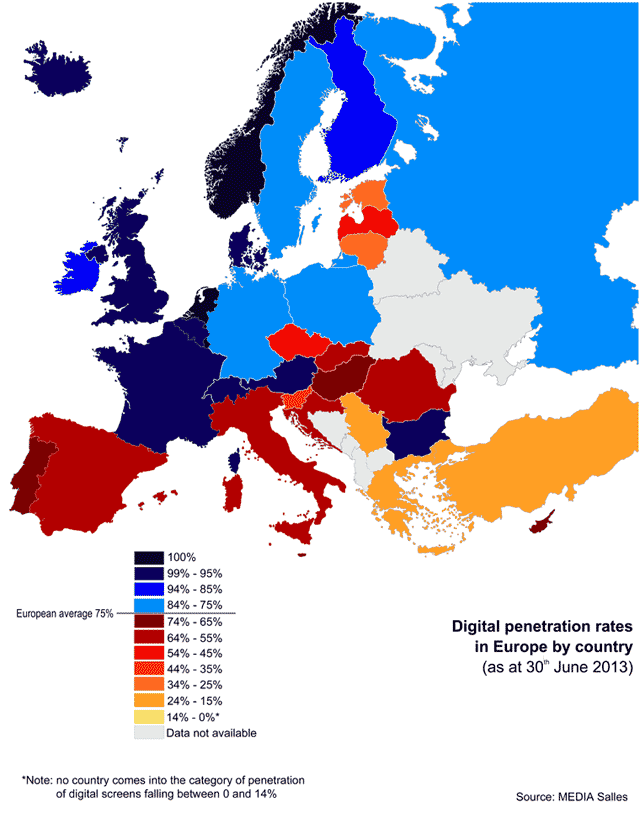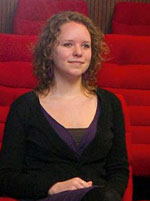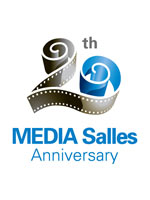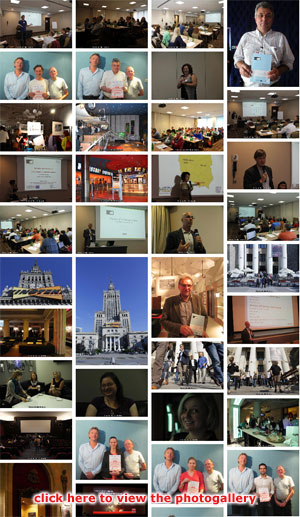
Reg.
Trib. Milano n. 418 del 02.07.2007
Direttore responsabile: Elisabetta Brunella
International Edition No. 98 - year 8 - 8 November 2013 |
***
|
|
||
 | |||
DigiTraining Plus: New Technologies for the European Cinemas of the Future. An account of the tenth edition It was Poland's turn to host the tenth edition of DigiTraining Plus: New Technologies for the European Cinemas of the Future, the MEDIA Salles course addressing European cinema professionals who wish to keep up-to-date with the new technologies. Poland: a variety of economic models for digitalizing different types of cinemas In the case of Poland, which by mid-2013 had digitalized 904 screens, or around three quarters of its screens, digitalization is based on a variety of economic models, according to the different types of cinemas. The evolution of technology Mike Vickers, Treasurer of MEDIA Salles, opened the tenth edition of the course by showing pictures of the newly revived Thurso cinema - the northernmost in the UK - which re-opened in 2012, placing all its bets on digital technology. He stressed the prime objective of the digital transition: to enhance the role of the cinema as a place of entertainment and cultural activity and to make sure that the big screen can be enjoyed by a growing number of spectators, taking cinema to places where it is lacking today. Careful programming and communication with the public Petr Vitek, the genial co-founder of the Aero in Prague, a landmark for quality cinema, gave participants a series of examples of how to involve the public in promoting a cinema. The visits: digital technology at the service of the cinema and diverse audiences One of the strong points of the DigiTraining Plus course are the visits to cinemas where digital technologies are used to offer the public diverse and innovative programming. What will tomorrow's cinemas be like? A glance at the cinemas of the future came in the talk that concluded the course and was given by Ron Sterk, Director of the Dutch Exhibitors' Association (NVB) and Cinema Digitaal, the initiative that has allowed cinemas in the Netherlands to attain 100% digitalization. Sterk stressed the importance of starting to "think digital". Making a break with old models linked to traditional film and discovering new potential and innovative ways of working are much greater challenges - but also more exciting ones - than just changing your equipment. This, according to Sterk, is the new way of thinking that will make a theatre's lease of life longer. To those who believe that they do not have the necessary resources, Sterk pointed out a successful path experimented in the Netherlands: that of cooperation. It was by joining forces that the Dutch exhibitors - even those running the smallest theatres - managed to digitalize thanks to a collective VPF model, and again thanks to cooperation that "Cinéville" was created, a monthly subscription allowing free access to arthouse cinemas in Amsterdam and nine other towns. Thus independent cinemas, too, were able to equip themselves with a tool that in the past had been a prerogative of the leading European chains. |
| FOCUS ON ACCESSIBILITY
Amongst the most interesting challenges for the movie theatres of the future is undoubtedly increasing accessibility, in other words opening up the cinema-going experience to those with impaired sight or hearing. Argentina: a handbook published on accessibility in cinemas Last August in Argentina, the Instituto Nacional de Cine y Artes Audiovisuales presented the publication "La accesibilidad a los medios audiovisuales: la narración en lengua de señas argentina y el subtitulado para personas sordas". France and the UK: accessibility already in place The Fontenelle may appear to be a small cinema site, just like many of the others that serve one of the numerous small towns scattered over the region of Paris. If Marly-le-Roi (population 16,000) is less famous than its neighbour Versailles, it is just as "proud of its royal origins", but at the same time "looks to the future".
This is what the municipal website has to say and the same philosophy seems to inspire the Fontenelle, a traditional art-house cinema yet recently equipped with two digital screens, which has always laid emphasis on quality programming. But what makes the Fontenelle an avant-garde cinema is also its ability to address spectators with difficulties in seeing or hearing. The cinema offers films with French subtitles for spectators with hearing impediments and - when a film has a channel available for audio description - titles suitable for the sight-impaired. The situation at the Fontenelle thus already proves to be in line with European policy, which demands that cinemas take steps to provide a service for all types of spectators. This is the spirit of article 7 of the EU's AVMSD (Audiovisual Media Services Directive), which reads:
"Why on earth should the hearing-impaired not have the chance to be cinema lovers?" comments Pascal Humbert, manager of the Lido cinema in Castres, which has been offering versions suitable for the hearing-impaired since last June.
As a consequence, for some weeks, audiences in this small town in the region of Toulouse have been witnessing screenings with rather different subtitles from those generally provided for films in their original language. To make them more useful to those who have a hearing impediment, for example, the words are colour-coded according to the character who speaks them. Capital letters are used if the actor is shouting and comments are provided to describe sounds. "The only disadvantage," continues Pascal Humbert, "is that there are still very few films available in this version." On a larger scale, the experiences of the Fontenelle or the Lido are offered in France by a group that covers the whole country, Gaumont Pathé, whose cinemas provide films subtitled for the hearing-impaired on Thursdays and Saturdays. It is not only France that is determined to move towards a goal which - as the European directive states - must progressively be adopted by exhibitors in Europe, but also Great Britain. Here the big chains - Vue, Odeon and Cineworld - offer a range of services including audio descriptions and subtitles on individual devices, such as mini-screens or glasses, made available by the cinema to those who ask for them. The transmitter/receiver on the glasses is also a support for the audio channel, with descriptions for the sight-impaired. What makes these options feasible is without doubt digital technology. With 35mm film, the channel for the hearing-impaired was created by the audio processor, whilst the narrative channel for the sight-impaired was only available on an "Accessibility Disc for Digital Theatre Systems". Digital has improved this situation dramatically: channels for those with hearing or visual impediments are already available in the files the cinema receives together with the film and no particularly complex equipment is necessary for them to be used. We often ask ourselves what tomorrow's cinema will be like. One of the keywords will certainly be accessibility, or the possibility of getting rid of physical or sensorial barriers, so that a growing number of people can enjoy the experience of cinema on the big screen. The Italian version of this article was published in "Cinema & Video International" no. 10/11, October-November 2013. |
WOMEN IN DIGITAL CINEMA
Jorien Scholtens, Researcher at the Netherlands Film Research Foundation (Stichting Filmonderzoek)
For more information, contact: jorien@filmonderzoek.nl
 In my living room there are two cinema seats, single-handedly removed from a cinema a couple of years ago. They are very old, their dark red colour has faded and they are not at all comfortable, but they remind me of the magic of the big screen, and my love of sitting in the dark watching great films. Fortunately I do not leave my passion for film at home, I take it with me to work everyday, where I research the Dutch film industry. I'm a Master in Film Studies and a researcher at the Netherlands Film Research Foundation (Stichting Filmonderzoek), see www.filmonderzoek.nl/english. The Foundation carries out researches on the film industry in the Netherlands commissioned by the exhibitors and distributors associations and other market parties. An interesting coincidence is that the founding father of Stichting Filmonderzoek is
In my living room there are two cinema seats, single-handedly removed from a cinema a couple of years ago. They are very old, their dark red colour has faded and they are not at all comfortable, but they remind me of the magic of the big screen, and my love of sitting in the dark watching great films. Fortunately I do not leave my passion for film at home, I take it with me to work everyday, where I research the Dutch film industry. I'm a Master in Film Studies and a researcher at the Netherlands Film Research Foundation (Stichting Filmonderzoek), see www.filmonderzoek.nl/english. The Foundation carries out researches on the film industry in the Netherlands commissioned by the exhibitors and distributors associations and other market parties. An interesting coincidence is that the founding father of Stichting Filmonderzoek is Dr Joachim Ph. Wolff, who has been scientific advisor to the MEDIA Salles Yearbook for many years. Over the last three years I have learnt from him what good research is all about.
Dr Joachim Ph. Wolff, who has been scientific advisor to the MEDIA Salles Yearbook for many years. Over the last three years I have learnt from him what good research is all about.
The aim of our research is to provide practical knowledge to the film industry, by establishing accurate and useful data on audiences and industry developments. I contribute to this with research on the audience perception and market for our national cinema - an English translation of the conclusions will be available soon - and of course with my research project on digital cinema. My first report about digitisation appeared last year and it stressed the expected impact of the Dutch digital cinema roll-out, based on interviews with exhibitors and distributors. The Cinema Digitaal project that contributed to the 100% digitisation of all screens in The Netherlands had just started. While there was no clear vision for the digital future, there was certainly no lack of progressive pioneers with innovative ideas. Inspiring discussions I had with exhibitors and distributors about this innovation - seemingly invisible to the public - made digital cinema a fascinating topic for further investigation. Now that digitisation has reached its conclusion in The Netherlands and more experience has been gained, the research project is being followed up with a new study. I will now focus on possible changes in the size and scale of new film releases as well as experiences now that all cinemas are digital.
I hope that my research can contribute to a better understanding of what the impact of digitisation is and that my conclusions can be shared within the international community. During the Dutch Film Festival that was held in Utrecht at the end of September I observed the true impact of digitisation, as young filmmakers are given the opportunity to show and view their films on the big screen much more easily and cheaply than was possible in the 35mm era. In the long term this will be a valuable contribution to the importance of the cinema screening room. And, in my opinion, that's what digitisation should be all about: keeping the cinema theatre as the main stage for sharing the magic of film, now and in the future.
This column hosts portraits of cinemas in Europe and the rest of the world which are quite different from one another but have in common the fact that they have all adopted digital projection.
Splendid Palace, Riga (LV)
(Per leggere il testo in italiano cliccare qui)
|
News on digitalisation worldwide United Kingdom: the Digital Funding Partnership completes its digital roll-out The success of the initiative has also been recognized by the British Culture Minister, the Hon. Ed Vaizey, who emphasized the fact that, thanks to the efforts of the DFP, the UK will be one of the first countries to attain full digitalization. It is certainly the first country to do so without using public money. |
|
Germany and Austria: UCI Kinowelt installs the Locksmith system Thanks to an agreement between Arts Alliance Media (AAM) and the Odeon & UCI group, the Locksmith system is to be installed in 25 cinemas and 231 screens belonging to the UCI Kinowelt chain operating in Germany and Austria. |
|
ITALY: Regional Support for Digitalization * LAZIO LOMBARDY * The present text updates the articles published in DGT online informer nos. 91, 89, 88, 82 (Per leggere il testo in italiano cliccare qui) |
|
"ADDED" CONTENT United Kingdom: The Audience in live cinemas Italy: coming soon, the British Museum's Pompeii |
|
USA: in Seattle the first digital projector using laser technology |

MEDIA Salles' contacts and
address
MEDIA Salles
Piazza Luigi di Savoia, 24 - 20124 Milano - Italy
Tel.: +39.02.6739781 - Fax: +39.02.6690410
E-mail: infocinema@mediasalles.it
Website: www.mediasalles.it
 I am happy to open this new issue of the DGT Online Informer by presenting the most recent statistics on digitalization in Europe, updated at 30 June 2013 and published in the
I am happy to open this new issue of the DGT Online Informer by presenting the most recent statistics on digitalization in Europe, updated at 30 June 2013 and published in the 

 created in 2010 by the UK Cinema Exhibitors' Association for the digitalization of independent British exhibitors - announced at the beginning of September that its project had been completed with the installation of digital projectors on around 300 screens taking part in the initiative.
created in 2010 by the UK Cinema Exhibitors' Association for the digitalization of independent British exhibitors - announced at the beginning of September that its project had been completed with the installation of digital projectors on around 300 screens taking part in the initiative.